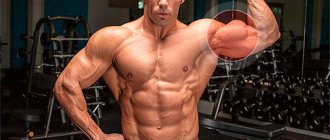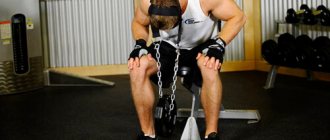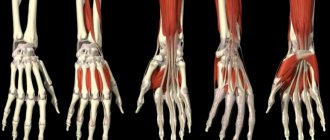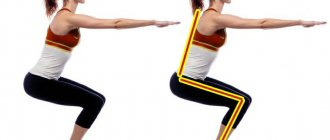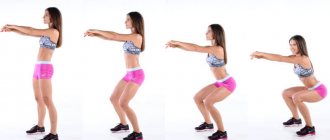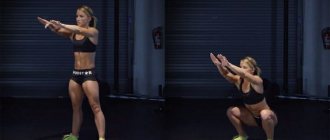If huge biceps and pectoral muscles are external beauty, then a strong neck is a must! Here are some great exercises and workouts for building a strong neck.
If you wake up in the morning and feel stiffness in your neck, know that this is the first alarm bell. It's time to learn how to shake your neck to get rid of unpleasant sensations!
Have you ever wondered why it hurts not only in the neck, but also in the trapezius and deltoid (shoulder) muscles? The answer is simple: they all relate to the neck area. Since these muscle groups support the head, they need to be developed and exercised regularly. In this article you will find a strength training consisting of the most effective exercises that will allow you to forget about the skinny neck of a teenager and pump up the powerful neck of a real athlete!
Anatomy of the cervical spine
The cervicothoracic part of the body consists of fifteen muscles. Ten of them are directly related to the cervical muscles, and five are passing through the upper body. Both types are divided into median and lateral.
Due to the lateral muscles, the jaw and larynx function. There is no point in pumping them up. Due to the lateral cervical muscles, the head can tilt, and they are also responsible for the volume of the neck. This muscle group is trained to pump up. The lateral muscles include superficial and deep groups. Due to the deep ones, a person can breathe and tilt the skull, while the superficial ones protect important parts of the spine and trachea. They also take part in turning and tilting the head. The deep group includes the four scalene muscles, the superficial group consists of the subcutaneous muscle and the sternocleidomastoid muscle.
The importance of training
For a man, a strong neck is an indicator of health. The neck should look trained, with well-developed chest muscles, broad shoulders and toned arms.
Neck training is important for women, due to the fact that gymnastics for her will allow her to pump up a flabby neck, avoid the appearance of a double chin, and generally improve her condition. If a girl pays attention to her décolleté area, she will be able to keep her neck youthful for a long time.
Also, if the muscles are well developed, this will help avoid the appearance of osteochondrosis and neck pain. Since there are numerous vessels and nerve endings in the neck, training it will ensure normal intracranial pressure and protect against spasms and headaches.
Who needs to pump up their neck muscles?
To reduce the risk of pain and injury, everyone can benefit from training these muscles. Most of us today have sedentary work at a computer, in which case pumping the neck muscles helps prevent cervical osteochondrosis. A strong neck reduces the pressure you can put on it and prevents soreness if you are in an awkward position for a long time.
In addition, during a stressful situation, the muscles of the trapezius and neck are under tension, and strong muscles reduce it. To reduce stress, stretch more.
Athletes of all sports (and especially martial arts) believe that pumped up neck muscles are extremely useful. Not only do they protect against collisions in contact sports, but they can also prevent concussions from impacts. In MMA, Brazilian Jiu-Jitsu and other combat sports, locks and neck holds are common, so developing a powerful neck is important not only for beauty, but also to prevent associated injuries. Wrestling bridges on the ground, when you need to hold not only your own weight on your neck, but also the weight of your opponent, are unthinkable without strong muscles.
In bodybuilding, a strong neck provides stability during heavy-weight compound exercises, such as squats and overhead pull-downs. And in everyday life, it is important for us to be able to look at our feet, up, to the side, and even just look back! And finally, you must agree that pumped-up neck muscles attract attention, because a strong neck is a sign of a tough guy!
Anatomical features of the neck muscles
The basis of the neck is made up of seven interconnected vertebrae; our mobility is ensured by their special structure and the presence of muscles. All neck muscles are divided into three groups: superficial, middle and deep.
The median muscles are responsible for the functioning of the jaw and larynx. The deep muscles of the neck are divided into lateral and prevertebral groups, which perform the function of tilting forward and to the side. You use them, for example, during the warm-up before training to pump up, say, your shoulders, when you tilt your head back and forth and left and right.
The lateral muscles provide elongation of the neck and shape its width, forming a muscle bundle directly above the collarbone. Bodybuilders strive to work this particular neck muscle because it provides full development of the back and a beautiful, symmetrical appearance from the front. And working out all the neck muscles helps develop more visible trapezius muscles and provides additional support for the spine.
Unfortunately, many training programs do not include neck exercises. Ideally, to achieve the best results, you need to dedicate a separate workout to the neck muscles, or do them after targeted work on the abs or forearms on days when you are not training the main parts of the body.
Preparation for classes
Before you start doing neck exercises, you need to do a preparatory warm-up. It helps warm up the muscles and prevent sprains.
The most suitable exercises for warming up:
- Tilts in different directions.
- Turns left and right. You should try to touch your ear to your shoulder.
- Rotational movements to the left and to the right.
- To warm up the side muscles, you need to raise your arm up, bend it at the elbow and reach for the ear on the other side.
- For the neck muscles in front, make a lock with your fingers and move them to the back of the head. While holding your head, bend backwards.
- For the back muscles of the neck, you need to rest your palms on your forehead and try to bend forward.
All exercises are done at a slow and calm pace. You cannot make sudden movements and increase speed. If you do not follow simple rules, severe pain may occur.
Exercises are performed 5-7 times. When performing them, you need to feel the tension and tension of the muscles. Warm-up duration is 3-5 minutes.
Warm-up before neck muscle training
Whatever muscle group we work on, we first need to do a warm-up, and the neck muscles are no exception. Warm-up is necessary in order to warm up the muscles, disperse the blood, and avoid injuries, muscle spasms and overexertion.
Warm-up for the neck muscles is familiar to all of us from school physical education lessons. These are standard head turns left and right, head tilts up and down, circular rotations of the head in different directions, and so on.
When doing the warm-up, try to keep all your movements smooth and calm, do not rush, do not chase the speed of the exercise, otherwise you will only harm yourself. Do not perform more than five repetitions of each exercise on one side, as this can also lead to negative consequences.
Exercises
Exercises for the neck and shoulder girdle can be performed with your own weight, or may involve the use of additional weight.
Working with your own weight
In these exercises, you overcome the strength of your arms and your own body weight. The easiest options:
Using your palms and chin:
- keep your head straight and rest your chin in your palms;
- overcoming resistance, tilt your head down;
- when the lowest point is reached, strain your neck and try to tilt it back using your hands;
- perform 3 sets of 15 repetitions.
Using your palms and the back of your head:
- fix the back of your head with your palms;
- create force and move your head back;
- then also push your head forward, resisting with your neck muscles;
- do 15 repetitions in 3 sets.
Bridge:
- lay something soft on the floor;
- starting position: lying on your shoulder blades;
- bend your knees and bend your spine;
- rise until the body is supported by the crown and feet;
- When performing the exercise, the body moves forward, pushing it using the force of the neck muscles.
Emphasis on the floor:
- rest your head on the floor;
- the legs are at a distance exceeding twice the width of the shoulders;
- roll your head from side to side;
- do 20 repetitions for each side.
With strap
It is also possible to pump up your neck using a strap. An additional weight is attached to this strap.
The correct method for lateral raises is:
- Lie on your side on the edge of the bench.
- Attach the strap to your head. The weight should hang freely without touching the floor.
- Slowly tilt your head vertically towards your shoulder and lift it up. First, you inhale, then hold your breath, and at the top point you need to exhale. The muscles are in constant tension. Repeat 10-12 times.
You can also train your neck muscles by moving your head away:
- Lie on your stomach on the bench. Fasten the strap. The collarbones should protrude slightly.
- Lower your head, inhale and, holding your breath, slowly lift it up.
- Then exhale and begin the reverse movement. Repeat 10-12 times.
Raising the head to the chest:
- Lie on your back on a hard surface, with your head hanging in the air.
- Attach the strap to your head.
- Pull your head back and lift, pressing your chin to your chest. Do 10-12 times.
With weights
After training for 2-3 months, you can start training with additional load. These exercises answer the question of how wrestlers swing their necks.
The correct way to perform an exercise with a plate on your stomach is as follows:
- lie on the bench with your stomach so that your head hangs in the air;
- put a pancake on your head;
- lift your head up and down;
- repeat 10-20 times.
Exercise with a plate on the back:
- lie on the bench with your back so that your head hangs down;
- put a pancake on your head;
- do head lifts 10-12 times.
Exercise with a plate on the side:
- lie on your side on a bench;
- place a pancake on your head;
- raise your head to the side 10-12 times;
- do the same on the other side.
When to stop exercising!
While pumping up your muscles, do not forget about the health of your cervical spine.
Please note - if you notice the following things in time, you will prevent a disaster:
- Your vision began to darken. After the first darkening, analyze why it happened. This may be a sudden change in body position. If your eyes become dark while at rest, you should think about it and stop exercising.
- No pumped-up muscle corset is worth your health problems. If a headache, insomnia and, most unpleasantly, sharp pain when turning the head appear, we stop exercising and go to a neurologist.
Muscle pain after exercise is normal. The main thing is to distinguish it from joint pain.
How to shake your neck is an understandable question, but, most importantly, you need to keep it healthy. Remember, the more mobility a joint has, the more vulnerable it is.
Common Mistakes
The most common mistakes when performing exercises include:
- During the exercise, sudden movements are made. All movements must be carried out at a slow and calm pace.
- Too much weight is being used.
- Exercises with straps and weights should not be performed by beginners, as there is a high probability of injury.
Basic methods for developing neck muscle formations
If you have been involved in bodybuilding relatively recently and do not know how to pump up your neck at home, you should study the video of these workouts. Most of them involve performing strength-resistance exercises. It can be created either with a simulator, or with the strength of your own hands, or with the help of a partner.
Training system for quickly pumping up your neck
Cervical muscle formations are pumped up in the following ways:
- performing head bends downwards, returning it to its original state;
- performing various head tilts in all directions, as well as circular movements from left to right, and vice versa.
Most manuals on how to pump up your neck at home suggest doing exercises according to the following scheme:
- Take a comfortable position and fix your body vertically. In this case, you need to remember that the frontal plane will be the reference point, on which pressure is applied to create resistance. In addition, to do this you will have to place your parallel crossed palms on it.
- The next step is to apply pressure to the forehead using your palms to create tension in the neck muscles. In this case, it will be necessary to carefully lower your head down, and progressively increase the impact produced with the palm of your hand.
- After the first 2 stages have been completed, you can move on to performing head tilts to the sides, while you will have to create resistance with your hands. To do this, place the palm on the head in the area of the ear and temple, placing the elbow so that it forms an angle of 90 °. It is necessary to tilt your head, periodically changing your hand.
- After you pump up the muscle fibers, you can begin to perform circular movements of the neck around its axis. In this case, you will need to put pressure on your chin while moving your neck.
In the event that you do not know how to pump up your neck at home, be sure to control the number of approaches when performing the exercises listed above so that their number does not exceed 30. In addition, you can involve an experienced assistant in the training who knows well , what to do in order to pump up your neck correctly at home.
In this case, your partner will put pressure on your head, and you will mainly lie on the training bench with your head down, which will allow you to concentrate on performing these exercises.
Examples of ready-made programs
Before starting a workout, be sure to warm up.
You can strengthen your neck muscles at home using the following program:
- Performing weighted head lifts. Performed lying on a bench 10-12 times. First, the starting position is lying on your back, then on your stomach and on both sides.
- Shrugs with dumbbells. Take dumbbells of the same weight. Lower your arms along your body and raise your shoulders as high as possible.
- Lifting dumbbells in front of you. Stand up straight, dumbbells in your hands, hands down. Exhale and raise your arms in front of you, then to shoulder level and in front of you, without bending your elbows. Inhale and slowly return to the starting position.
- Raising dumbbells to the sides. The exercise is performed as the previous one, only the arms move to the sides.
- These exercises are repeated 6-12 times. Take a break of 2-3 minutes between exercises.
Dress correctly
Disadvantages can always be hidden with the help of well-chosen clothes.
If you want to visually lengthen your neck, this is suitable for you:
- An open collar gives the impression of a long, graceful neck.
- V-shaped or deep round neckline - neckline “a la Brigitte Bardot”.
- Long or medium beads and necklaces.
- Jackets without a collar, worn without a blouse.
- Sweaters with a hood.
- Loosely tied scarves - do not overload the neck.
- Short haircuts and pinned hair high.
Not recommended:
- High necklines - boat neckline, etc., as well as bows
- Dresses and tank tops
- Polo collar - makes a short neck wider
- Mandarin and golf collars
- Scarves tied high accentuate a flaw
- Necklaces and necklaces
Tips and tricks
For strengthening to proceed correctly, you must follow these tips:
- Give your neck muscles a rest. You can get a relaxing massage.
- If the next day there is a pulling sensation in the neck area, then this is normal and means that the training was successful.
- If after training there is acute pain in the neck, then this is also not scary. However, you need to give your neck a couple of weeks to rest. During this time she will recover. You can visit a traumatologist.
- If there is such acute pain in the neck that it cannot be moved, then it is possible that the vertebrae have shifted. The reason for this may be too much force or too much weight. It is necessary to call an ambulance.
- The main rule when pumping up your neck is not to overdo it. It’s better to underdo it a little and not get a serious injury. The best solution in this matter would be to train with a trainer. However, if this is not possible, then it is necessary to strictly follow safety precautions and monitor possible signs of injury.
- Many people ask: how long does it take to pump up your neck? Everything here is individual and depends on the regularity of training and the correctness of their implementation.
Text Neck Correction
Our digital age creates specific deformations of the neck statics associated with moving the head forward towards gadgets. “Doctors called this phenomenon “text neck syndrome,” and it is very different from the usual “age-related” neck posture,” says Anastasia Dubinskaya, psychophysiologist, head of the Revitonika school of natural rejuvenation, teacher at the National Medical Research Center for Rehabilitation and Balneology of the Ministry healthcare of the Russian Federation. “ The head freezes in the position of a giraffe, over time the platysma (the superficial muscle of the neck) separates and the ribbed segments of the larynx appear (a trough-like depression appears on the neck).”
In the photo: Anastasia Dubinskaya, psychophysiologist, head of the school of natural rejuvenation “Revitonika”, teacher at the Federal State Budgetary Institution “National Medical Research Center for Rehabilitation and Balneology” of the Ministry of Health of the Russian Federation.
The exercise allows you to:
- step by step restore the correct cervical deflection;
- relieve stress from all anterior structures of the neck;
- reduce tension and swelling in the larynx;
- lengthen the back of the neck.
44330400_338457130238465_2961560625724314411_n
How to perform
Keep your head straight. We clasp the fingers of both hands and place them on the occipital region, placing the thumbs on the border of the hairline. Let's fixate in this position until we feel close contact of our hands with the back of the head for about 5-10 seconds. Next, gently press the occipital region onto your hands and fixate in this position for at least 1 minute. We perform from 1 to 3 times a day.
How long to do: 1 minute.
Contraindications: all diseases of the thyroid gland (hypothyroidism, hyperthyroidism, autoimmune thyroiditis, nodular goiter, cysts, nodes).
Safety comes first
Before performing any physical exercise, it is necessary to warm up those muscle groups that will be subject to stress. General warming up of the body will also not be superfluous and will contribute to overall physical strengthening.
The neck is the part of the body where injuries are most dangerous and can even lead to hospitalization.
This is fraught with long, painful treatment and the need to undergo a rehabilitation course. The reasons may be different: pinched nerve, vertebral displacement, muscle strain. To avoid such troubles, be sure to do a thorough warm-up before physical activity. This requirement is relevant for everyone, beginners and experienced athletes.
